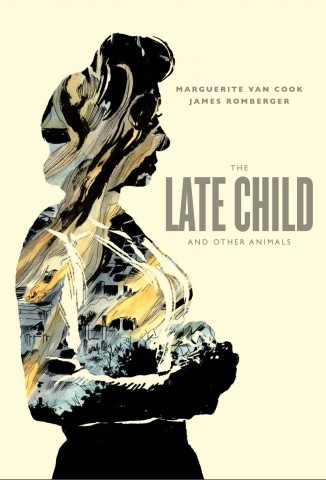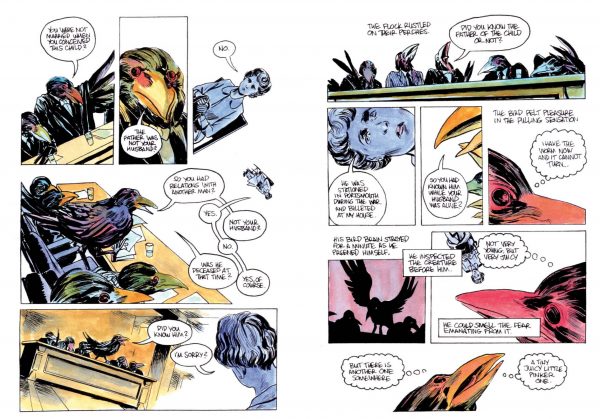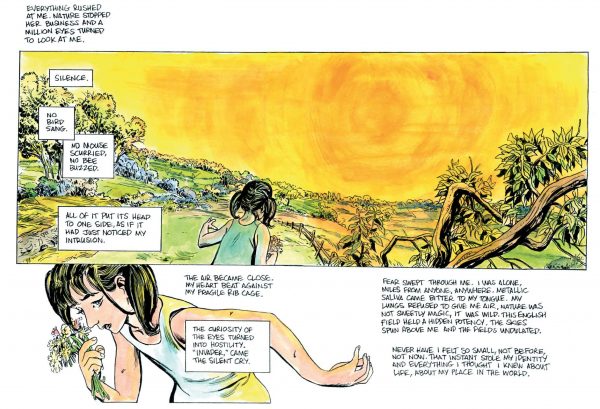The Late Child and Other Animals
Written and colored by Marguerite Van Cook
Adapted and drawn by James Romberger
Fantagraphics Books
The Late Child and Other Animals opens in the middle of the blitz with two wide-eyed young women—sisters Hetty and Daisy—gazing down from a hillside upon the aftermath of another air raid over Portsmouth, a city on the southern coast of England. What unfolds in the 180 fluidly illustrated pages that follow is a fragmented chronicle of life as memory and memory as mosaic, its linear arrangement contingent upon the cycle of gathering and loss, revelation and vexation that polka-dot the soil of growth. Rather than opening this modest but lush account of the past with her own childhood, Van Cook begins by lyrically reimagining her mother’s wartime solitude, the tightly-wound community surrounding her, and the compassionate choice that Hetty (her mother), makes to build a future approximating family. Confronted at the end of the chapter with the official stigma assigned to war widows, Van Cook tells us “The solid oak headboard of Hetty’s bed sparkled, as if it had been varnished with glitter. But a closer inspection showed that the effect came from tiny glass shards,” the residue of a bomb exploded in the garden years earlier.

Structured along a timeline that excludes events we never miss, each of the five episodes comprising The Late Child… abides striking shifts in perspective and stands alone in singular fashion. Romberger takes Van Cook’s approach as a cue to illuminate her words through a pentaprism that underscores the unique vision of each part. Jettisoning the tone of quasi-romance that peppers the first part—which Van Cook paints in largely monochromatic palettes (blue and gray streets, a brown and green bomb-blasted garden, for example)—Marguerite’s second section explores a Kafkaesque encounter that her partner illustrates by heightening the hallucinatory nature of bureaucratic predation with outsized animal renderings that invert the symbolic white of Lewis Carrol’s rabbit with the oily shimmer of ravens’ plumage. This shattering, inquisitorial “Outing” (its title) relates Hetty’s resolve to persevere as a single mother, having born Marguerite out of wedlock, the issue of an aborted tryst with a rootless lodger. Although granted rights of motherhood, “Hetty cried on the way home,” recalls van Cook. “She had cried so often, tears came like old friends. So much of her life had to be conducted in the shadows now. Even though the news was good, she felt as though the ground under her feet was gone… she was spent… she was always on the edge now.” Here, van Cook’s theme starts to take shape, tracing our emerging acknowledgement of women’s issues during the last half of the twentieth century. Hardly a political screed, the dramatic and emotional depth of this social shift benefits from Romberger’s and Van Cook’s attention to details that reflect Hetty’s inner life: the sinking sensation she has in the tribunal waiting room literally floods the space; her frozen impotence and burning rage are colored from icy blue to fiery red with a subtlety reminiscent of German filmmaker Fassbinder’s theatrical lighting schemes; and her sole ally—the receptionist—suffers from a colorless pallor that reads as the cost of her subservience to the ravenous guile of her masters.

We finally meet Marguerite as a child in the third part of the novel. Beginning with one of those adult prohibitions all children find impossible to follow, imprecations that accordingly furnish one with an affinity for the value of secrets more than anything else, young Marguerite embarks on a solo adventure through “Arreton Downs.” Amid these untrammeled hills on the Isle of Wight, Marguerite encounters the nurturing bosom of a vital Nature’s abundance, a bewildering idyll that exposes her to its own challenging secrets. Her return home under cover of the crepuscular sky is cushioned by the elemental consciousness of Mr. Chiverton, an ancient “tenant of one of the wee 17th century cottages of which my stepfather, ‘Uncle Bert,’ was now the landlord.” As attuned to her disorientation as he is to the living earth under his every footstep, Chiverton stops picking his early Brussels sprouts to observe, “Had quite a day, haven’t you? Yas, you’re a late child… You has to watch out up there.” Unsure she’s heard right, she spells nothing out, just as “He didn’t qualify the comment.” Romberger lends weight to her trek into Arreton’s wilderness by drawing several breathtakingly lush tableaus across the entire two-page spread that drip with a vibrant cacophony of colors that leap from the flora and fauna fueling Marguerite’s initial delight. As she stubbornly defies Nature’s quixotic temper, color fills the bowl of heaven with a molten sun that flows from the margins, a celestial impact that can only compel the tiny child to retreat.

The remaining chapters lead one to ponder experiences that shaped one’s own path to the threshold of adolescence, just as the previous chapters inspire one to reflect on the forces confronted by those who engendered us. Van Cook contrasts divergent inner voices to outline the darkest event of her youth, and Romberger imposes his brush-like pen on visual citations ranging from Degas’ dancers to Fritz Lang’s M to Jules Dassin’s Rififi. As Marguerite’s mother retreats from the evil that men do, the child turns to her peers. “Perhaps she felt guilty,” she discloses of her mom. “But then again, it was so much more convenient when she was free of me, even for a few hours.” Untethered from the threadbare ties of her mother’s apron, Marguerite locates the final section in France, where her friend Catherine’s family exposes her to a world of intrigue that eclipses the fatherland she’s known. The sumptuous, sensual passions of Latinate culture pour through Romberger’s ink, each step of her journey filling his frames like the copious banquet that carries Marguerite from curiosity to indulgence to overthrow and acceptance. Van Cook’s ultimate observation in this deftly illustrated compilation of journal entries is spelled out over a full page image of Marguerite plunging, buoyant, into the surf: “I understood the Norman mind and the stories I had read by Maupassant, which though they had once horrified me, now made sense.” One could read the overall impression conveyed by The Late Child… in terms of the McLuhanesque evaluation of comic books and strips as “cool media,” forms that “provide very little data about any particular moment in time, or aspect in space, of an object. The viewer, or reader, is compelled to participate in completing and interpreting the few hints provided by the bounding lines.” (“Comics,” in Understanding Media: The Extensions of Man, by Marshall McLuhan) Although true of The Late Child… with its thoughtfully composed diaphony of picture and text, such a reading would imply the collaborators had but a partial awareness of their task. Yet, so sublime is the telling in its subtle interplay of perspectives—visual, vocal, lucidly ludic—that to deny these creators’ willful intent to invite our active rumination through its ample provision of entry—and departure—points would be selling them short. The Late Child and Other Animals breaks fresh ground for alternative ways to retrace the past; opens one up to the interplay of parallel lives. Just as the ego uses our fear to reach “the moment when our fledgling passion discovers its own emptiness,” (Raoul Vaneigem, The Revolution of Everyday Life) in The Late Child… (Marguerite) can conclude, “This was the season when I realized that I must leave my loves behind.” And so must one ask on closing this book, “What must I leave (what must I have left) behind?”
–Norman Douglas
Comics Reviews